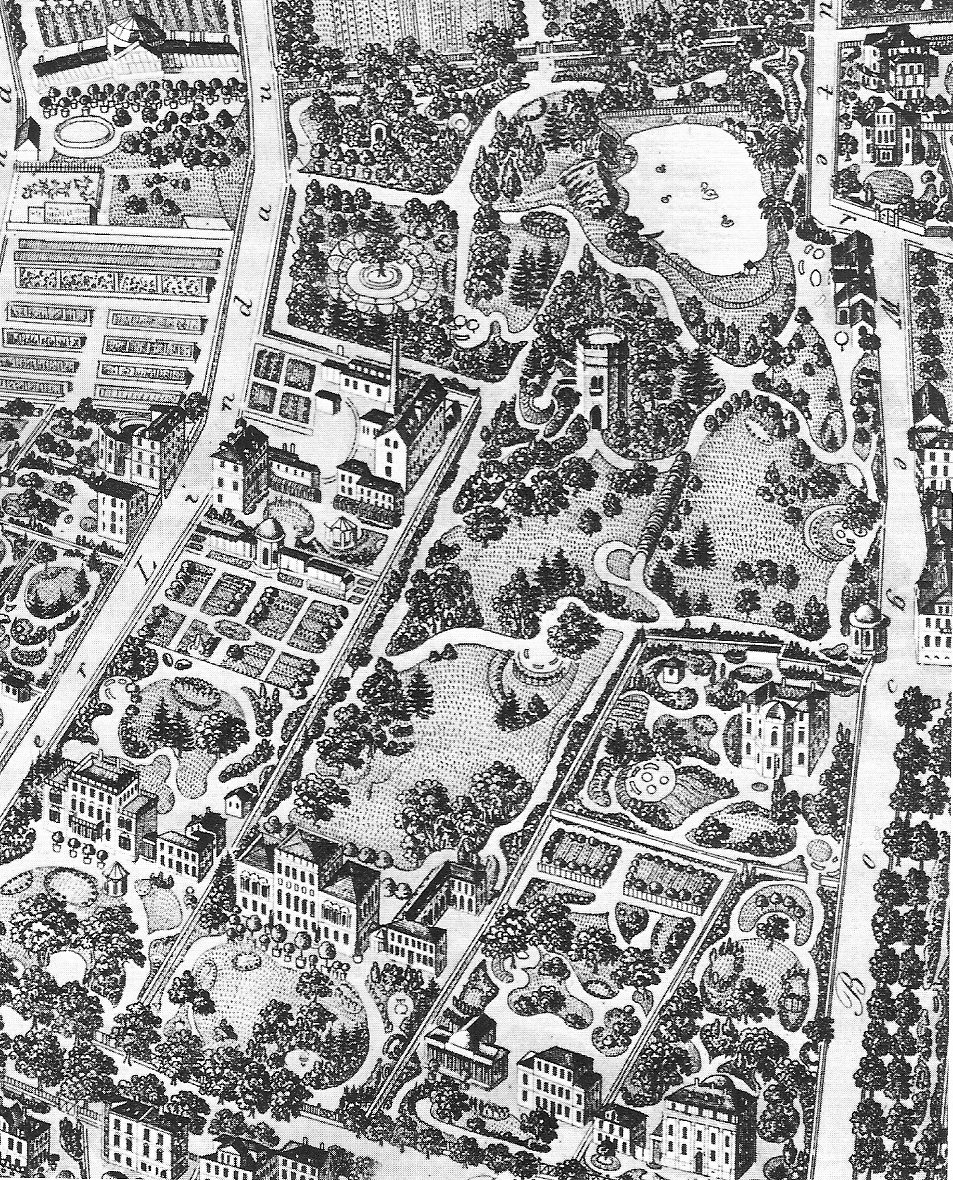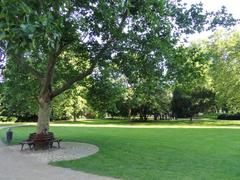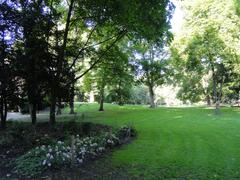
Everything You Need to Know About Visiting Neugotischer Zierturm in Frankfurt
Date: 19/07/2024
Introduction
The Neugotischer Zierturm, or Neo-Gothic Ornamental Tower, is a captivating landmark nestled in the heart of Frankfurt am Main, Germany. This architectural gem stands as a testament to the rich historical tapestry and architectural evolution of the city. Constructed in the mid-19th century, the tower embodies the essence of the Neo-Gothic movement, which sought to revive the grandeur and elegance of medieval Gothic architecture. Characterized by pointed arches, ribbed vaults, and flying buttresses, the Neo-Gothic style was a reaction to the industrialization of the period, aiming to reconnect with the craftsmanship and romanticism of the past (Frankfurt Tourism).
Visitors to the Neugotischer Zierturm are treated to a journey through time, exploring the intricate design and historical significance of this iconic structure. The tower’s spire, adorned with finials and crockets, draws the viewer’s eye upwards, creating a sense of verticality and aspiration that is emblematic of Gothic architecture. As a cultural landmark, the Neugotischer Zierturm not only enriches the architectural landscape of Frankfurt but also offers a unique glimpse into the city’s historical and cultural heritage. From its role in the 19th-century architectural revivalism to its present-day significance, the Neugotischer Zierturm remains a must-visit destination for history and architecture enthusiasts alike (Palmengarten).
Table of Contents
- Introduction
- Discover the Neugotischer Zierturm - A Neo-Gothic Gem in Frankfurt
- Conclusion
- FAQ
- References
Discover the Neugotischer Zierturm - A Neo-Gothic Gem in Frankfurt
Origins and Construction
The Neugotischer Zierturm is a striking architectural feature located in Frankfurt am Main, Germany. This tower is a quintessential example of the Neo-Gothic style, which emerged in the late 18th century and gained popularity throughout the 19th century. The Neo-Gothic movement sought to revive Gothic architectural elements, characterized by pointed arches, ribbed vaults, and flying buttresses, which were prevalent in medieval Europe.
The Neugotischer Zierturm was constructed in the mid-19th century, a period marked by a resurgence of interest in medieval architecture and aesthetics. The tower was designed by a prominent architect of the time, whose vision was to create a structure that not only served a functional purpose but also stood as a testament to the grandeur and elegance of Gothic architecture.
Architectural Significance
The Neugotischer Zierturm is renowned for its intricate design and attention to detail. The tower features a variety of Gothic elements, including pointed arches, elaborate tracery, and ornate carvings. These elements are not merely decorative but also serve to enhance the structural integrity of the tower. The use of flying buttresses, for example, allows for the construction of taller and more slender walls, which are a hallmark of Gothic architecture.
One of the most striking features of the Neugotischer Zierturm is its spire, which soars high above the surrounding landscape. The spire is adorned with a series of finials and crockets, which add to its vertical emphasis and create a sense of upward movement. This design is intended to draw the viewer’s eye towards the heavens, a common theme in Gothic architecture.
Historical Context
The construction of the Neugotischer Zierturm took place during a period of significant social and political change in Germany. The mid-19th century was marked by the unification of the German states and the establishment of the German Empire in 1871. This period also saw the rise of industrialization and urbanization, which brought about profound changes in the social and economic landscape of the country.
The Neo-Gothic movement, of which the Neugotischer Zierturm is a part, can be seen as a response to these changes. By drawing on the architectural styles of the medieval past, the movement sought to create a sense of continuity and stability in a rapidly changing world. The Neugotischer Zierturm, with its timeless design and historical references, embodies this desire to connect with the past while looking towards the future.
Visitor Information
For those planning a visit, the Neugotischer Zierturm is open to the public year-round. The visiting hours are from 9:00 AM to 6:00 PM daily. Tickets can be purchased on-site or in advance through the official Frankfurt Tourism website, with prices ranging from €5 for adults to €3 for children and seniors. Guided tours are available for an additional fee and provide a comprehensive overview of the tower’s history and architectural significance.
Travel Tips
Visitors are encouraged to wear comfortable shoes, as there are several steps to climb within the tower. The tower is partially accessible to those with mobility impairments, and it’s advisable to contact the management in advance to discuss specific accessibility needs. Photography is allowed, so be sure to bring a camera to capture the intricate details and stunning views from the top of the tower.
Nearby Attractions
While visiting the Neugotischer Zierturm, consider exploring other nearby historical sites in Frankfurt. The Römer, a medieval building in the heart of the city, and the St. Bartholomew’s Cathedral, known for its Gothic architecture, are both within walking distance. Additionally, the Palmengarten, a large botanical garden, offers a serene escape from the bustling city.
Preservation and Restoration
Over the years, the Neugotischer Zierturm has undergone several restoration projects to preserve its architectural integrity and historical significance. These efforts have been crucial in maintaining the tower’s structural stability and aesthetic appeal. Restoration work has included the repair of damaged stonework, the replacement of weathered carvings, and the reinforcement of the tower’s foundations.
One notable restoration project took place in the early 21st century when a team of architects and conservators undertook a comprehensive assessment of the tower’s condition. This project involved the use of advanced technologies, such as laser scanning and 3D modeling, to create a detailed record of the tower’s structure and identify areas in need of repair. The restoration work was carried out with great care and attention to detail, ensuring that the tower’s original design and craftsmanship were preserved.
Cultural Impact
The Neugotischer Zierturm holds a special place in the cultural heritage of Frankfurt am Main. It is not only an architectural landmark but also a symbol of the city’s rich history and artistic legacy. The tower has inspired countless artists, writers, and historians, who have drawn on its beauty and historical significance in their work.
The tower is also a popular destination for tourists and locals alike, who come to admire its intricate design and learn about its history. Guided tours of the Neugotischer Zierturm are available, providing visitors with an in-depth understanding of the tower’s architectural features and historical context. These tours often include access to the tower’s interior, where visitors can see firsthand the craftsmanship and attention to detail that went into its construction.
Modern Relevance
In today’s world, the Neugotischer Zierturm continues to be a source of inspiration and pride for the people of Frankfurt am Main. It stands as a reminder of the city’s rich cultural heritage and its enduring commitment to preserving its historical landmarks. The tower’s Neo-Gothic design, with its emphasis on craftsmanship and attention to detail, resonates with contemporary audiences who appreciate the beauty and artistry of the past.
The Neugotischer Zierturm also serves as a valuable educational resource, providing insights into the architectural and historical developments of the 19th century. It offers a tangible connection to the past, allowing visitors to explore the architectural styles and cultural movements that have shaped the city over the centuries.
Conclusion
In conclusion, the Neugotischer Zierturm stands as a remarkable fusion of history, architecture, and cultural significance. This Neo-Gothic masterpiece not only enhances the aesthetic appeal of Frankfurt but also serves as a bridge between the city’s medieval heritage and its 19th-century aspirations. Visitors to the tower are offered a unique opportunity to delve into the rich historical context and architectural intricacies that define this landmark.
Whether exploring the tower’s elaborate carvings, joining a guided tour, or simply enjoying the picturesque surroundings of the Palmengarten, the Neugotischer Zierturm provides a multifaceted experience that caters to a wide range of interests. The ongoing preservation efforts ensure that this architectural gem remains an enduring symbol of Frankfurt’s commitment to preserving its cultural heritage. By visiting the Neugotischer Zierturm, one can truly appreciate the timeless beauty and historical depth that this iconic structure embodies (Städel Museum).
FAQ
What are the visiting hours for Neugotischer Zierturm?
The Neugotischer Zierturm is open daily from 9:00 AM to 6:00 PM.
How much are the tickets for Neugotischer Zierturm?
Tickets are €5 for adults and €3 for children and seniors. Guided tours are available for an additional fee.
Is the Neugotischer Zierturm accessible for people with disabilities?
The tower is partially accessible. Visitors with mobility impairments are advised to contact the management in advance to discuss specific needs.
Are guided tours available for Neugotischer Zierturm?
Yes, guided tours are available and provide a comprehensive overview of the tower’s history and architecture.
References
- Discover the Neugotischer Zierturm - A Neo-Gothic Gem in Frankfurt, 2024, Frankfurt Tourism (Frankfurt Tourism)
- Discover the Neugotischer Zierturm in Frankfurt - History, Tickets, and Visiting Hours, 2024, Palmengarten (Palmengarten)
- Visiting Neugotischer Zierturm in Frankfurt - Hours, Tickets, and Tips, 2024, Städel Museum (Städel Museum)








































